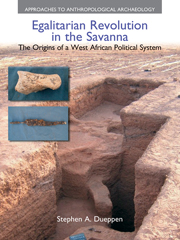Book contents
- Frontmatter
- Dedication
- Contents
- List of Figures
- List of Tables
- Acknowledgments
- 1 Decentralization and the Evolution of Egalitarian Behaviors in Sedentary Societies
- 2 Ancient Villages in the Niger Bend: Context and Methods for Exploring the Voltaic Region
- 3 Ethnographic Perspectives on Western Burkina Faso: A Survey
- 4 Kirikongo: An Introduction to the Site, the Setting, and the Research Design
- 5 The West African Environmental Setting: Kirikongo in Ecological Context
- 6 Stratigraphies and Depositional Episodes: The Excavations
- 7 Relative Chronology: Ceramics
- 8 Community Growth at Kirikongo: The Spatial and Temporal Setting
- 9 Early Sedentary Life in the Voltaic Region: Defining a ‘Voltaic Tradition’
- 10 Craft Production at Kirikongo: The Origins, Development and Reinterpretation of Specialization
- 11 Herding, Farming, and Ritual Sacrifice: The Economy from Kirikongo
- 12 Death and Ritual Objects at Kirikongo: House-Based Social Differentiation
- 13 Archaeological Patterns and Social Process: Reconstructing Changing Life at Kirikongo
- 14 Land, Spiritual Power, and Gerontocracy: An Exploration of the Roots of Egalitarian Revolution in the Western Voltaic Region
- 15 Hierarchy and Egalitarianism within the Niger Bend: Revolution and the Triumph of Communalism
- Bibliography
- Index
4 - Kirikongo: An Introduction to the Site, the Setting, and the Research Design
- Frontmatter
- Dedication
- Contents
- List of Figures
- List of Tables
- Acknowledgments
- 1 Decentralization and the Evolution of Egalitarian Behaviors in Sedentary Societies
- 2 Ancient Villages in the Niger Bend: Context and Methods for Exploring the Voltaic Region
- 3 Ethnographic Perspectives on Western Burkina Faso: A Survey
- 4 Kirikongo: An Introduction to the Site, the Setting, and the Research Design
- 5 The West African Environmental Setting: Kirikongo in Ecological Context
- 6 Stratigraphies and Depositional Episodes: The Excavations
- 7 Relative Chronology: Ceramics
- 8 Community Growth at Kirikongo: The Spatial and Temporal Setting
- 9 Early Sedentary Life in the Voltaic Region: Defining a ‘Voltaic Tradition’
- 10 Craft Production at Kirikongo: The Origins, Development and Reinterpretation of Specialization
- 11 Herding, Farming, and Ritual Sacrifice: The Economy from Kirikongo
- 12 Death and Ritual Objects at Kirikongo: House-Based Social Differentiation
- 13 Archaeological Patterns and Social Process: Reconstructing Changing Life at Kirikongo
- 14 Land, Spiritual Power, and Gerontocracy: An Exploration of the Roots of Egalitarian Revolution in the Western Voltaic Region
- 15 Hierarchy and Egalitarianism within the Niger Bend: Revolution and the Triumph of Communalism
- Bibliography
- Index
Summary
As elsewhere in the world, the nature of social, economic, and political organization in ethnographically described Voltaic societies leaves a variety of material correlates in the archaeological record, including settlement structure, craft production, consumption debris, etc. In particular, comparative long-term analyses of the basic social unit, the social house, as microcosms of community, reveal extensive understandings about community, and societal processes over time. With an overall goal of understanding the developmental trajectory of Capron's ‘communal project’, the highly differentiated egalitarian social formations found in parts of western Burkina Faso, I initiated research in the Mouhoun Bend, an area where surveys by Holl and Koté (2000) had identified a variety of well-preserved Iron Age sites with potentially long chronological sequences. Upon Koté's invitation, I chose the previously untested site of Kirikongo, located 7 km southwest of Douroula and directed two seasons of excavations (2004 and 2005/2006) at the ancient village.
Kirikongo is a remarkable archaeological site for understanding the changing nature of houses and community over the past two millennia. It is a grouping of small occupation (house) mounds resulting from sedentism or long-term repeated occupation that together form a single settlement (mound cluster). Mounded Iron Age sites are common throughout West Africa, although their spatial arrangements and relative sizes represent many variants on a scale of complexity, ranging from hamlets and villages to more urban settings (e.g. Marchal 1978; McIntosh 1995; Togola 1996, 2008; Holl and Koté 2000). At Kirikongo, the discrete mounds (separated by flat spaces) indicate clear prehistoric spatial (and social) divisions, and provide a unique opportunity to explore long-term social change in indigenous social categories (houses).
- Type
- Chapter
- Information
- Egalitarian Revolution in the SavannaThe Origins of a West African Political System, pp. 55 - 69Publisher: Acumen PublishingPrint publication year: 2012



